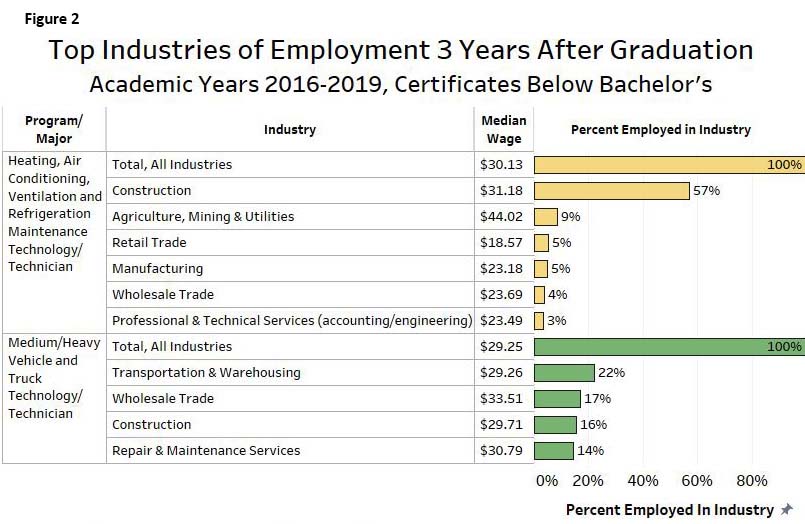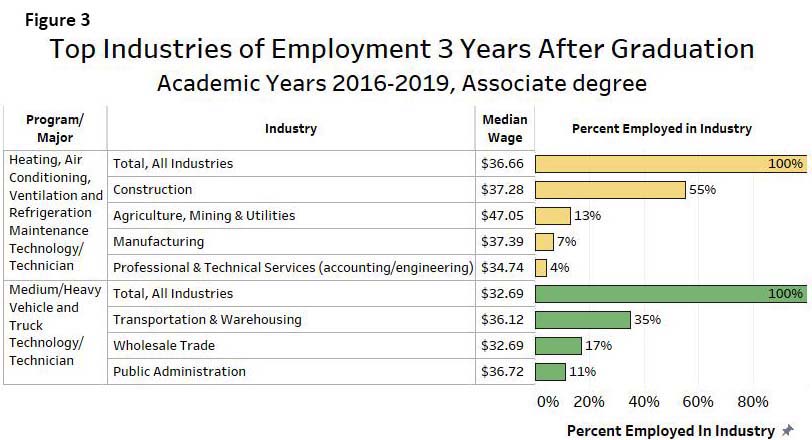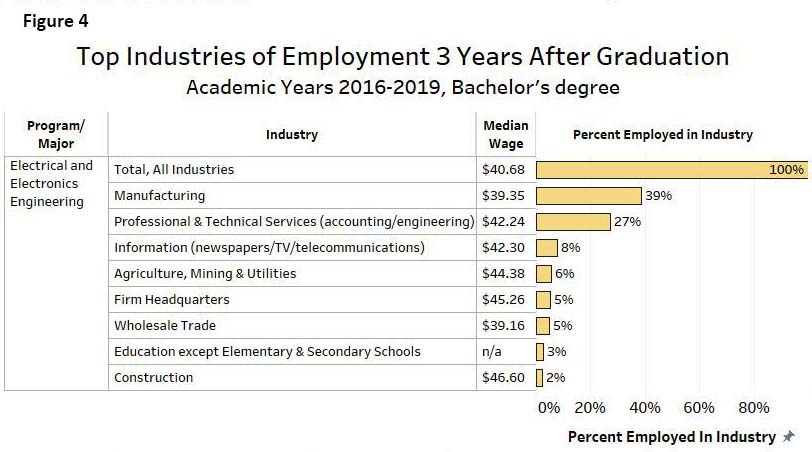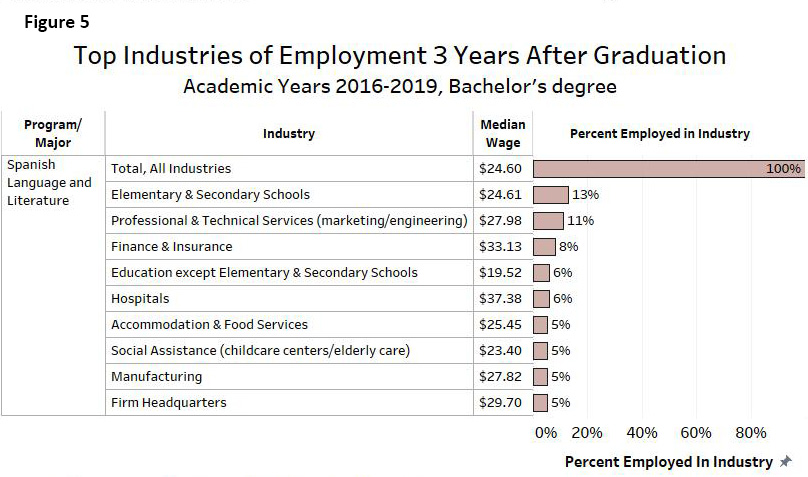
by Alessia Leibert
March 2024
When choosing a major it's hard to know what to expect. Will future earnings justify today's investments in a college education? Upon completion of a major, where will I work? Do I envision myself working in the industries where most other graduates in my major have found employment?
The Minnesota Department of Employment and Economic Development (DEED) just released the College Major to Industry of Employment tool, showing which industries hired graduates from 405 different postsecondary majors. Thanks to this unprecedented level of detail, users can explore the following questions:
The tool is an ideal companion to the Graduate Employment Outcomes (GEO) tool, which represents the collaborative efforts of DEED and the Minnesota Office of Higher Education to collect and securely link workforce with education data through the Statewide Longitudinal Educational Data System (SLEDS).
To show how the tool works, Figure 1 explores the outcomes of certificates in Nursing Assistant/Aide and Patient Care Assistant/Aide. To navigate to this result, users can either select "Health Professions & Related" from the Field of Study filter or type "nursing assistant" in the keyword search field.
Figure 1
What careers can this program potentially lead to? How much can I expect to earn upon completion of the instructional program? Does the program improve my chances of finding a job in the industries and work settings of my choice/for which I prepared?
Answers offered by the tool, using Nursing Assistant/Aide as an example:
This information is relevant both before and after graduation. Before deciding a major, this evidence helps lay out the professional paths and work settings available for different instructional program options, so students can compare before committing to a particular course of study. After graduation, it can help graduates target their job search efforts to industries with an actual history of recruiting from the program at good wages.
How large is this workforce pipeline? Is this program well aligned with industry needs? What are the overall strengths and weaknesses of the pipeline?
Answers offered by the tool, using Nursing Assistant/Aide as an example:
This evidence can help program planners understand the broader impact of their program within the labor market and demonstrate to stakeholders that they are meeting industry needs. And if the program is not meeting industry needs, the tool can offer clues as to why.
With rising college tuition costs, vocational and trade schools are seeing a revival in popularity. But not all vocational programs are created equal. Graduates' earnings outcomes vary dramatically by occupational focus. Gender of participants is also a factor driving program performance. In contrast to most female-dominated sub-baccalaureate programs like the one displayed in Figure 1, most male-dominated ones yield median wages that are well above the family-sustaining wage threshold. Figure 2 displays two certificates within the Mechanic & Repair Technician field of study as examples.

In the case of HVAC Technicians, 57% of students landed jobs in Construction with wages of $31.18, and 9% in Utilities, also a related industry, at even higher wages. In the case of Medium/Heavy Vehicle & Truck Technicians, the top four industries—making up 69% of employed graduates—fit well with the program's occupational focus and offer excellent wages.
The tool allows us to look up the same majors at the associate award level (Figure 3). When comparing Figure 2 with Figure 3 we notice a nearly identical industry distribution with higher wages, suggesting that additional training in these majors further boosts industry-readiness and earnings potential. This information can help students weigh the costs and benefits of enrolling in a certificate versus an associate's degree program in these fields.

Wages in these majors are even above those earned three years post-graduation by bachelor's degree holders overall in academic year 2018-20193.
Engineering is one of the best-paying majors in Minnesota. Figure 4 displays the outcomes of Electrical and Electronics Engineering graduates, 39% of which had jobs in Manufacturing at median wages of $39.35. The second most popular industry of employment, Professional & Technical Services, yields even higher wages ($42.24). The top six industries are well aligned with the occupational focus of the program.

To wrap up this overview we examine a program in the humanities. Figure 5 displays the outcomes of recipients of a bachelor's degree in Spanish Language & Literature. The program leads to median wages of $24.60, below the overall median of $27.85 for bachelor's degree holders but significantly above Minnesota's family-sustaining wage.

Hovering over the data bars we discover that this major might prepare graduates for work as Interpreters and Translators, Foreign Language Teachers, and Secondary Teachers in general. However, like most programs, this list of occupations is not exhaustive of career options available to graduates, because certain skills sets are transferable to a variety of careers. The top industry of employment is Elementary & Secondary Schools, where there is high demand for Spanish-speaking teachers, teaching assistants, and community liaisons. The second top industry of employment, Professional & Technical Services, is seemingly unrelated to this major but pays even higher wages than Elementary & Secondary Schools. Why? Because this industry needs Spanish speakers in roles as varied as marketing specialists, sales representatives, survey and communications specialists. The same is true for the Finance & Insurance industry, which absorbed 8% of employed graduates at very good wages. The payoffs to this major are high also in Hospitals, where graduates may have found jobs as interpreters. A variety of businesses with Spanish-speaking customers can benefit from employees who are fluent in the language and possess the writing, communication and research skills learned through a humanities degree.
Choice of major is truly the key to economic success after graduation. While it is good to explore careers early and let career interests drive choice of major, sometimes it is nearly impossible to chart a detailed career path in advance. Knowing the industries of destination of recent graduates can reduce uncertainty by offering a reality check about earnings potential and work settings available down the road. The empirical evidence from the College Major to Industry of Employment tool, briefly summarized in this article, can help students and families navigate training options.
1In the absence of information on students’ specific job roles, we use industry as a measure of alignment with employer needs. For example, we can’t tell whether a Registered Nursing graduate was employed as a Registered Nurse, but we know whether he/she was employed in the Healthcare industry.
2According to the cost of living tool, $19.46 is the minimum wage needed to sustaining a typical family in Minnesota. This benchmark is based on the fact that the most typical family structure in Minnesota is one fulltime worker, one part-time worker, and one child.
3The overall median for Bachelor's degree holders three years after graduation for the 2018-2019 cohort was $27.85. Source: Graduate Employment Outcomes Tool, 2018-2019 cohort.